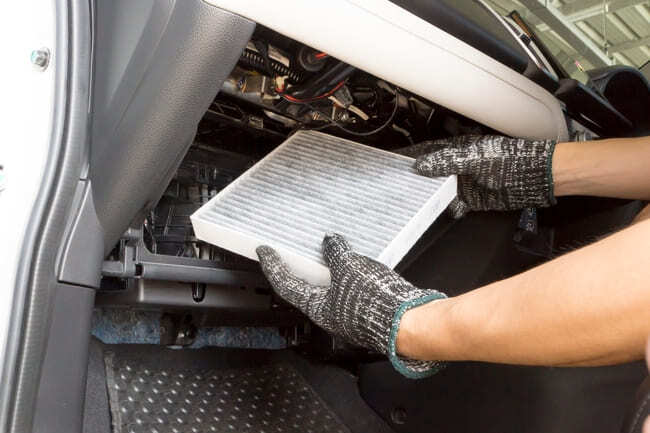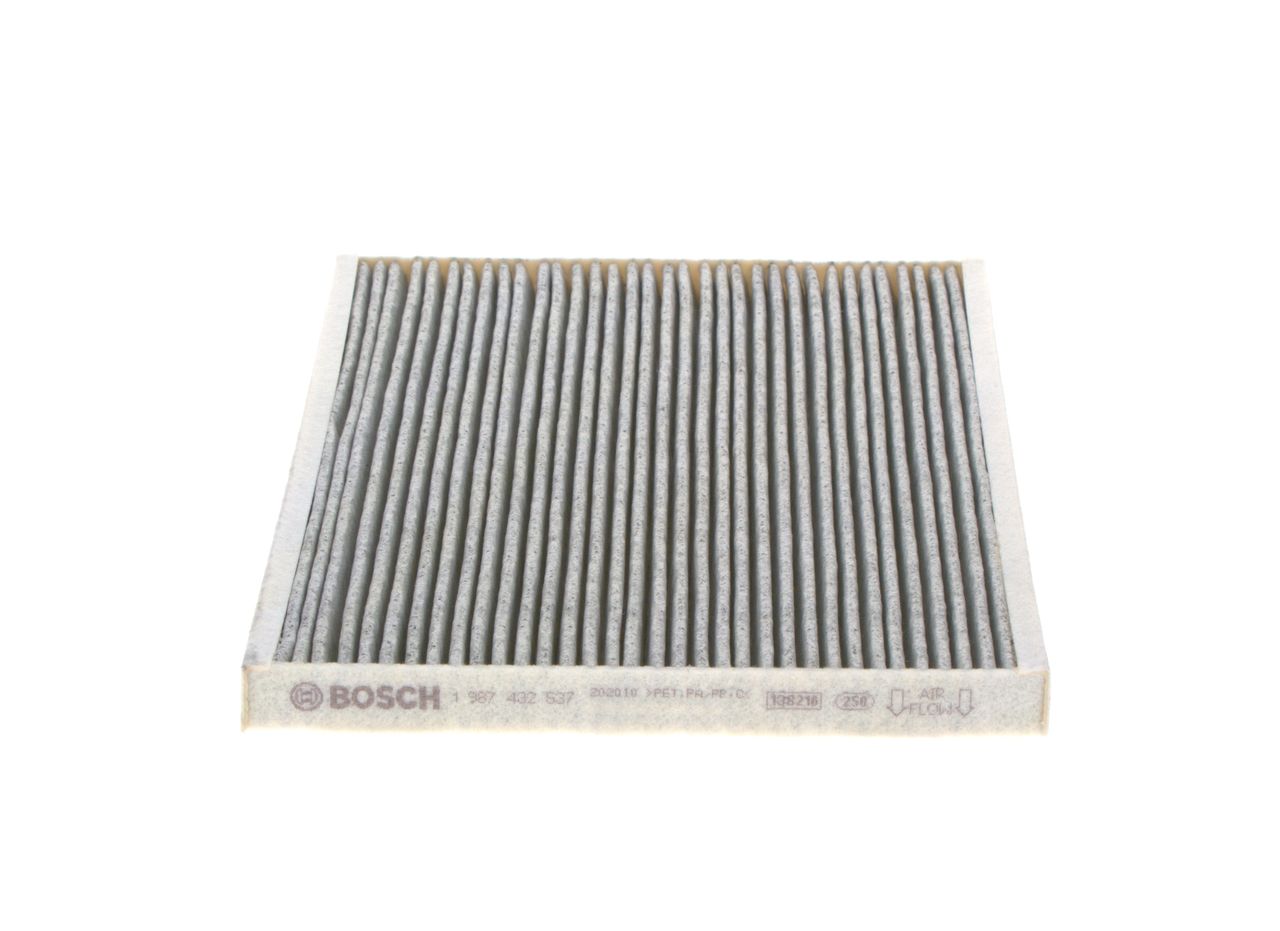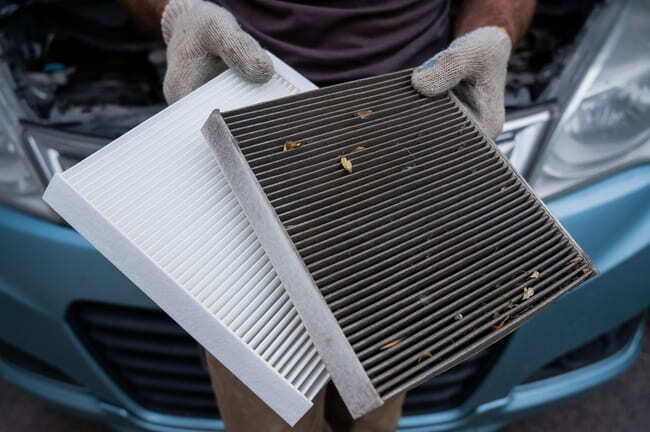Table of Contents
Cabin air filter replacement: How often, how to change it, and cost
Noticing stale smells or poor airflow in your car? A dirty cabin air filter might be the cause. Here we'll explain why the filter is important, how to know when to replace it, and how to do it yourself in a few easy steps.
How to change a cabin air filter
You can change your cabin air filter in minutes using basic garage car tools like a screwdriver. It’s also useful to keep a cloth at hand to clean the filter housing. We have provided this step-by-step guide to help you replace your cabin air filter easily and with confidence.
1. Locate the cabin air filter
Take a look at your owner’s manual to find out where the cabin air filter is. In many cars, it is behind the glove box. In other vehicles, the cabin air filter location might be under the dashboard or beneath the bonnet, close to the windscreen.

2. Open the access panel
If the filter is located behind the glove compartment, fully open the compartment and release the side clips to lower it out of the way. If the filter is in the dashboard or engine bay, remove any covers or panels to get access to the filter housing. Take care not to use force.
3. Remove the old filter
Carefully slide out the old filter. Note its orientation and direction of airflow, which is usually indicated by arrows on the edge of the filter.
4. Clean the area (optional)
Before fitting the new filter, use a hoover or a cloth to remove any leaves or debris from the compartment. This will help your new filter work more effectively.
 BOSCH Pollen filter
Activated Carbon Filter, 268 mm x 222 mm x 21 mm
BOSCH Pollen filter
Activated Carbon Filter, 268 mm x 222 mm x 21 mm
 BOSCH Pollen filter
Particulate Filter, 212 mm x 286 mm x 57 mm
BOSCH Pollen filter
Particulate Filter, 212 mm x 286 mm x 57 mm
 MANN-FILTER Pollen filter
Activated Carbon Filter with polyphenol, with antibacterial action, Particulate filter (PM 2.5), with fungicidal effect, Activated Carbon Filter, 216 mm x 186 mm x 30 mm
MANN-FILTER Pollen filter
Activated Carbon Filter with polyphenol, with antibacterial action, Particulate filter (PM 2.5), with fungicidal effect, Activated Carbon Filter, 216 mm x 186 mm x 30 mm
 MANN-FILTER Pollen filter
Activated Carbon Filter, 259 mm x 98 mm x 32 mm
MANN-FILTER Pollen filter
Activated Carbon Filter, 259 mm x 98 mm x 32 mm
 DENSO Pollen filter
Particulate Filter, 182 mm x 180 mm x 25 mm
DENSO Pollen filter
Particulate Filter, 182 mm x 180 mm x 25 mm
5. Install the new filter
Insert the new filter in the same direction as the old one, making sure you follow the airflow arrows. Check that it is seated properly and flush with the housing.
6. Refit panels and test
Secure the glove box cover back into place. Start the engine and test the air system to make sure it is working properly.
Can I change my cabin air filter myself?
Yes, most drivers can replace a cabin air filter within 15 minutes. It’s a simple DIY maintenance task for many vehicles. In most cases, the filter is usually behind the glove box. However, some models may require you to remove clips, small fasteners, or interior panels to access the filter housing.
Even if you're not particularly handy, the process is usually straightforward with the help of your owner's manual or an online tutorial. However, if you'd rather not tackle it yourself or if it looks too complex, your local garage can quickly replace it, often as part of a routine service.

How often should you change the air filter in your car?
You should replace your cabin air filter every 12,000–15,000 miles or once a year, whichever comes sooner. However, this schedule may need to be adjusted depending on your driving conditions. If you frequently drive in heavy traffic, polluted areas, or dusty environments, you may need to replace it more often. This ensures that the air inside your car stays clean and that your ventilation system continues to work efficiently.
A clean cabin air filter improves airflow, reduces allergens, and prevents unpleasant odours. Neglecting to replace it can cause poor air quality, foggy windows, and increased strain on your vehicle’s heating and cooling systems.
What happens if you don't change the cabin air filter on time?
If you don’t replace your cabin air filter on schedule, it can lead to reduced airflow, unpleasant odours, and a noticeable deterioration in the air quality inside your vehicle. As time passes, dust, pollen, and other debris build up in the filter, which can restrict airflow and reduce the efficiency of your car’s ventilation system.
You may experience misted-up windows that clear slowly, or worsening allergy symptoms while driving, particularly in city traffic or during high pollen seasons. In some cases, excess moisture and trapped debris can even lead to mould growth inside the system.
To avoid these problems, it is recommended that you replace the filter every 12,000–15,000 miles or once a year. Timely replacement ensures the air inside your car remains fresh and clean and helps maintain the performance of your heating and cooling system.

 MANN-FILTER Pollen filter
Activated Carbon Filter with polyphenol, with antibacterial action, Particulate filter (PM 2.5), with fungicidal effect, Activated Carbon Filter, 193 mm x 213 mm x 30 mm, FreciousPlus
MANN-FILTER Pollen filter
Activated Carbon Filter with polyphenol, with antibacterial action, Particulate filter (PM 2.5), with fungicidal effect, Activated Carbon Filter, 193 mm x 213 mm x 30 mm, FreciousPlus
 MANN-FILTER Pollen filter
Activated Carbon Filter with polyphenol, with antibacterial action, Particulate filter (PM 2.5), with fungicidal effect, Activated Carbon Filter, 244 mm x 143 mm x 32 mm
MANN-FILTER Pollen filter
Activated Carbon Filter with polyphenol, with antibacterial action, Particulate filter (PM 2.5), with fungicidal effect, Activated Carbon Filter, 244 mm x 143 mm x 32 mm
 MANN-FILTER Pollen filter
Particulate Filter, 254 mm x 235 mm x 32 mm
MANN-FILTER Pollen filter
Particulate Filter, 254 mm x 235 mm x 32 mm
 BOSCH Pollen filter
Activated Carbon Filter, 240,5 mm x 279 mm x 36 mm
BOSCH Pollen filter
Activated Carbon Filter, 240,5 mm x 279 mm x 36 mm
Cabin air filter replacement cost
In the UK, the part alone typically costs between £15 and £30 to replace a cabin air filter. If you choose to have it replaced by a mechanic or as part of a routine service, the total cost may range from £40 to £70, depending on your vehicle and the labour rates charged by the garage.
Replacing the filter yourself is a cost-effective option. Most filters are easy to access and require no special tools. You can purchase high-quality car cabin filters online or from local auto parts shops – just make sure that they are compatible with your car's make and model.
Filters containing activated carbon offer extra protection against odours and harmful gases and tend to be slightly more expensive, but are worth considering if you drive in busy urban areas.
Top products related to this topic:










